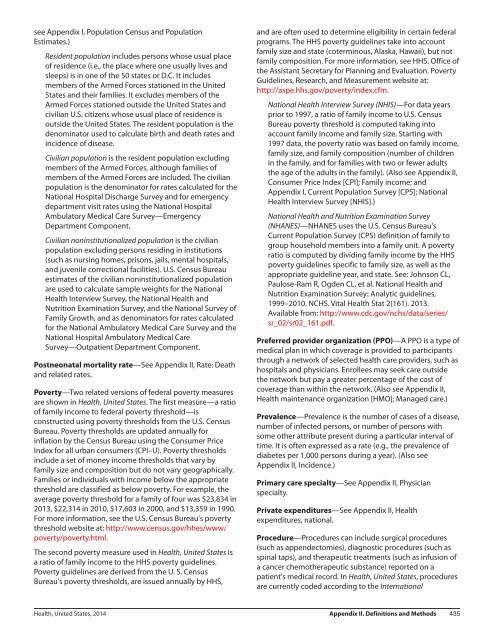hus14
hus14
hus14
Create successful ePaper yourself
Turn your PDF publications into a flip-book with our unique Google optimized e-Paper software.
see Appendix I, Population Census and Population<br />
Estimates.)<br />
Resident population includes persons whose usual place<br />
of residence (i.e., the place where one usually lives and<br />
sleeps) is in one of the 50 states or D.C. It includes<br />
members of the Armed Forces stationed in the United<br />
States and their families. It excludes members of the<br />
Armed Forces stationed outside the United States and<br />
civilian U.S. citizens whose usual place of residence is<br />
outside the United States. The resident population is the<br />
denominator used to calculate birth and death rates and<br />
incidence of disease.<br />
Civilian population is the resident population excluding<br />
members of the Armed Forces, although families of<br />
members of the Armed Forces are included. The civilian<br />
population is the denominator for rates calculated for the<br />
National Hospital Discharge Survey and for emergency<br />
department visit rates using the National Hospital<br />
Ambulatory Medical Care Survey—Emergency<br />
Department Component.<br />
Civilian noninstitutionalized population is the civilian<br />
population excluding persons residing in institutions<br />
(such as nursing homes, prisons, jails, mental hospitals,<br />
and juvenile correctional facilities). U.S. Census Bureau<br />
estimates of the civilian noninstitutionalized population<br />
are used to calculate sample weights for the National<br />
Health Interview Survey, the National Health and<br />
Nutrition Examination Survey, and the National Survey of<br />
Family Growth, and as denominators for rates calculated<br />
for the National Ambulatory Medical Care Survey and the<br />
National Hospital Ambulatory Medical Care<br />
Survey—Outpatient Department Component.<br />
Postneonatal mortality rate—See Appendix II, Rate: Death<br />
and related rates.<br />
Poverty—Two related versions of federal poverty measures<br />
are shown in Health, United States. The first measure—a ratio<br />
of family income to federal poverty threshold—is<br />
constructed using poverty thresholds from the U.S. Census<br />
Bureau. Poverty thresholds are updated annually for<br />
inflation by the Census Bureau using the Consumer Price<br />
Index for all urban consumers (CPI–U). Poverty thresholds<br />
include a set of money income thresholds that vary by<br />
family size and composition but do not vary geographically.<br />
Families or individuals with income below the appropriate<br />
threshold are classified as below poverty. For example, the<br />
average poverty threshold for a family of four was $23,834 in<br />
2013, $22,314 in 2010, $17,603 in 2000, and $13,359 in 1990.<br />
For more information, see the U.S. Census Bureau's poverty<br />
threshold website at: http://www.census.gov/hhes/www/<br />
poverty/poverty.html.<br />
The second poverty measure used in Health, United States is<br />
a ratio of family income to the HHS poverty guidelines.<br />
Poverty guidelines are derived from the U. S. Census<br />
Bureau's poverty thresholds, are issued annually by HHS,<br />
and are often used to determine eligibility in certain federal<br />
programs. The HHS poverty guidelines take into account<br />
family size and state (coterminous, Alaska, Hawaii), but not<br />
family composition. For more information, see HHS. Office of<br />
the Assistant Secretary for Planning and Evaluation. Poverty<br />
Guidelines, Research, and Measurement website at:<br />
http://aspe.hhs.gov/poverty/index.cfm.<br />
National Health Interview Survey (NHIS)—For data years<br />
prior to 1997, a ratio of family income to U.S. Census<br />
Bureau poverty threshold is computed taking into<br />
account family income and family size. Starting with<br />
1997 data, the poverty ratio was based on family income,<br />
family size, and family composition (number of children<br />
in the family, and for families with two or fewer adults<br />
the age of the adults in the family). (Also see Appendix II,<br />
Consumer Price Index [CPI]; Family income; and<br />
Appendix I, Current Population Survey [CPS]; National<br />
Health Interview Survey [NHIS].)<br />
National Health and Nutrition Examination Survey<br />
(NHANES)—NHANES uses the U.S. Census Bureau's<br />
Current Population Survey (CPS) definition of family to<br />
group household members into a family unit. A poverty<br />
ratio is computed by dividing family income by the HHS<br />
poverty guidelines specific to family size, as well as the<br />
appropriate guideline year, and state. See: Johnson CL,<br />
Paulose-Ram R, Ogden CL, et al. National Health and<br />
Nutrition Examination Survey: Analytic guidelines,<br />
1999–2010. NCHS. Vital Health Stat 2(161). 2013.<br />
Available from: http://www.cdc.gov/nchs/data/series/<br />
sr_02/sr02_161.pdf.<br />
Preferred provider organization (PPO)—A PPO is a type of<br />
medical plan in which coverage is provided to participants<br />
through a network of selected health care providers, such as<br />
hospitals and physicians. Enrollees may seek care outside<br />
the network but pay a greater percentage of the cost of<br />
coverage than within the network. (Also see Appendix II,<br />
Health maintenance organization [HMO]; Managed care.)<br />
Prevalence—Prevalence is the number of cases of a disease,<br />
number of infected persons, or number of persons with<br />
some other attribute present during a particular interval of<br />
time. It is often expressed as a rate (e.g., the prevalence of<br />
diabetes per 1,000 persons during a year). (Also see<br />
Appendix II, Incidence.)<br />
Primary care specialty—See Appendix II, Physician<br />
specialty.<br />
Private expenditures—See Appendix II, Health<br />
expenditures, national.<br />
Procedure—Procedures can include surgical procedures<br />
(such as appendectomies), diagnostic procedures (such as<br />
spinal taps), and therapeutic treatments (such as infusion of<br />
a cancer chemotherapeutic substance) reported on a<br />
patient's medical record. In Health, United States, procedures<br />
are currently coded according to the International<br />
Health, United States, 2014 Appendix II. Definitions and Methods 435


